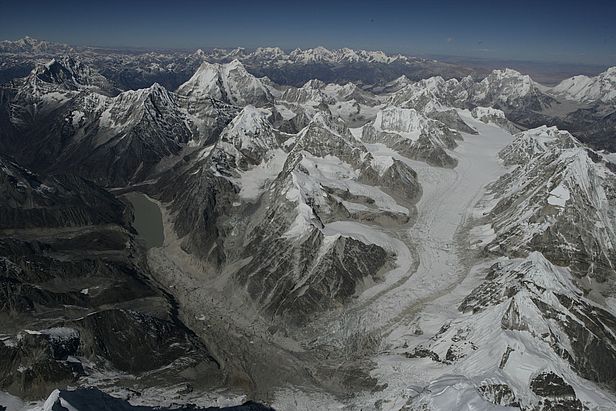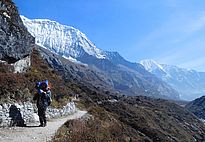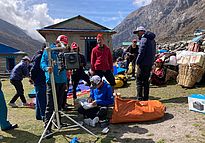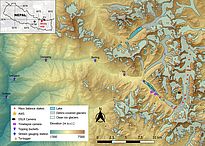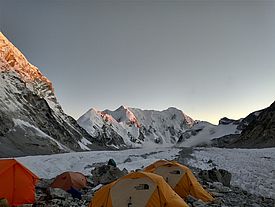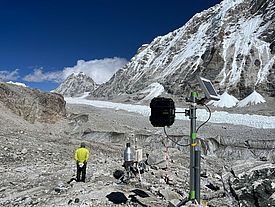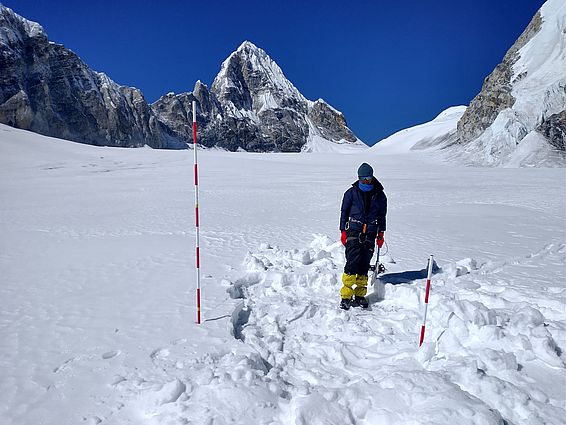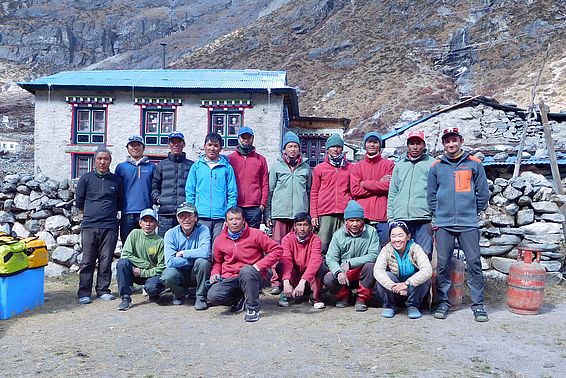13.12.2023 | Achille Jouberton | WSL News
Glaciers in the Himalayas have been melting faster than in other places in Asia. Last October, WSL doctoral student Achille Jouberton from the HIMAL group of Francesca Pellicciotti joined a scientific expedition to study the fast-melting Trakarding-Trambau Glaciers, close to the Everest region. In the WSL logbook, he relates his experiences in eastern Nepal.
From my personal diary: Day #16, 27 Oct 2023, Camp 4, 5600m a.s.l. Woke up at 2am with a headache, then again multiple times until 6:30am. Strong headache, felt like at Camp 1 a week ago. I prepared myself with difficulty and went for breakfast but could only eat half of it. Koji gave me pills for headaches and one for altitude sickness. At that time, I was almost sure I could not go with them to the glacier. Just when they were about to leave, I took the decision to try and go with them, and turn back if it’s too difficult after 30min, the time it takes for the medicine to kick-in. While a slight headache remained, I felt better soon and stayed with the team for the whole day, returning to Camp 4 at 3pm. […] Tomorrow is the last major workday […]. We should also be able to see Mount Everest! Weather forecast looks good, let’s hope I sleep reasonably well and wake up full of energy.
On my expedition with Professor Koji Fujita and his team from Nagoya University, I went up to nearly 6000m above sea level (a.s.l.) to study the Trakarding and Trambau glaciers in eastern Nepal. The Japanese professor has visited this research site since 2016 (with a COVID-break in 2020 and 2021). The fieldwork would be nearly impossible without the help of a professional trekking company. This year, our scientific team was accompanied by four Sherpas and up to 27 porters. It took us seven days from the last village accessible by bus (Gongar, 1276m a.s.l.) to walk to the glacier terminus (4600m a.s.l.). Throughout the expedition, the Sherpas managed the camp logistics, provided us with warm tea , meals and tremendous assistance with field tasks, route finding and safety on the glacier.
We slept at six different camps, located at increasing elevation up to 5600m a.s.l., with nighttime temperature plunging to -10/-15°C. The views from our camp became more and more breathtaking as we went up, and in the end we were surrounded by glaciers and 6000m+ high mountain peaks. While we went up progressively, headaches, fragmented sleep, and shortness of breath while hiking were common, further proving the need for the unvaluable support of local sherpas who are used to navigate in these environments. Nights felt very long, as we were in our sleeping bags between 6:30pm and 7am, leaving them regularly for uncomfortable but necessary toilet breaks. I definitely should have brought more books, as I had to ration the number of pages I allowed myself to read each day.
A unique monitoring site in the Himalayas ¶
Our field sites, the Trakarding and Trambau glaciers, are flanked by two automatic weather stations (AWS) at 4850 and 5450m a.s.l. and dotted with more than 15 mass balance stakes covering most of the glacier’s elevation range. The highest of them is up at breath-taking 6000m a.s.l. It is very rare to have such observations from the upper areas of Himalayan glaciers. However, the relatively easy access to the accumulation area – the upper part of the glacier where more snow accumulates than is lost each year – of Trambau Glacier is why Prof. Fujita chose it as a research site. I say relatively for a reason: it does require a great amount of planning beforehand, and three weeks carrying hundreds of kilograms of equipment up the mountains. I was very impressed by the strength and friendliness of all the porters who accompanied us, without whom this expedition would not have been possible.
I am studying the Trambau-Trakkarding glaciers area to understand the past and future dynamics in snowfall accumulation and glacier mass changes. While for most of the work I sit in front of my computer, I still need to go out in the field to check whether my model outputs are reasonable. During this fieldwork, I installed a digital camera at the highest weather station, to gain information on snow depth and precipitation dynamics, two important variables not monitored previously. I can only hope that the camera will withstand the extremely low temperatures and still be working when we come back next year.
As in the Alps, a difficult year for Himalayan glaciers ¶
2023 was another bad year for glaciers in Europe, with little winter snowfall and high summer temperatures. At the Nepalese Trambau-Trakarding glaciers, unfortunately, the situation was similar. I have witnessed myself that even at the highest measurement stake at about 6000m a.s.l. the surface sank by 1 meter. That’s the second largest loss since the beginning of observations in 2016, after 2022. “It doesn’t really look like an accumulation area” told us Professor Fujita, where only a twenty centimeters thick layer of snow was covering the glacier ice.
Because of the complex influence of the Indian summer monsoon on the simultaneous glacier ablation and accumulation, the explanation for such high mass loss will require further analysis of the meteorological data we just collected. Unlike in the European Alps, most of the precipitation here falls during the warmer summer months, whereas winters are cold and dry and do not influence the glacier mass balance substantially.
Walking back down to the village, I thought to myself that although this had been a once-in-a-lifetime experience, I would still be glad to be back to civilization and its comforts. I was sure it would take months, if not years before I would feel the desire to go back to such a remote and cold place. In reality, though, I already felt I was ready to go back to the mountains before the end of the first week back in Kathmandu.
Always up to date: Subscribe to the WSL Newsletter
Copyright ¶
WSL and SLF provide image and sound material free of charge for use in the context of press contributions in connection with this media release. The transfer of this material to image, sound and/or video databases and the sale of the material by third parties are not permitted.
